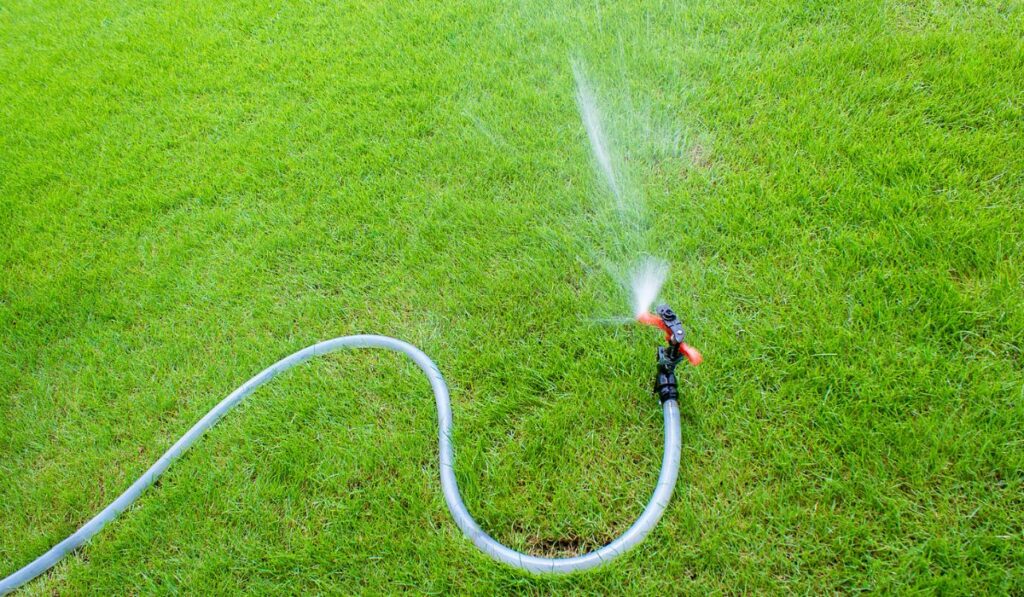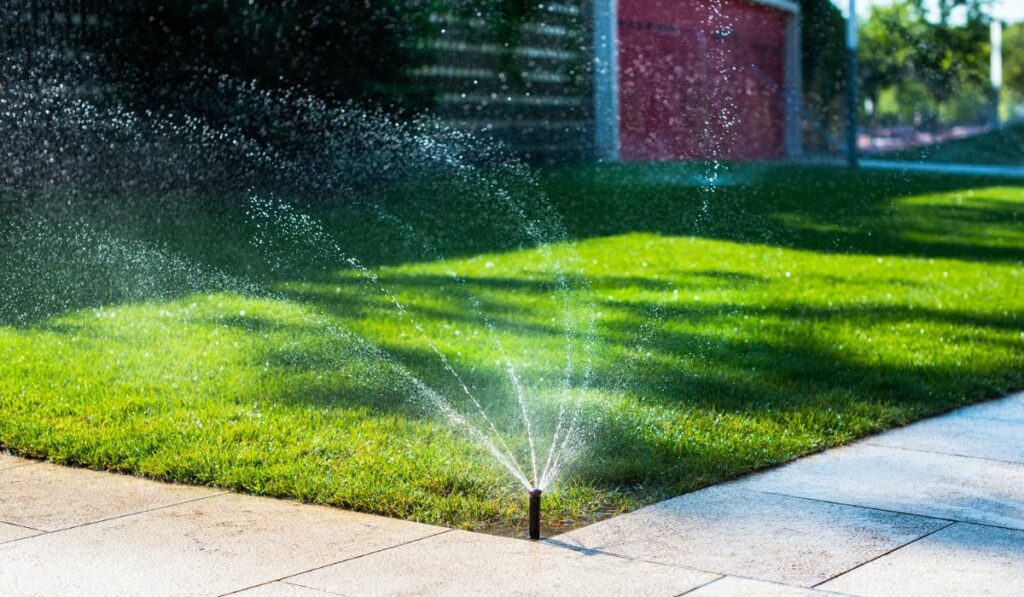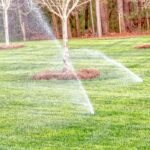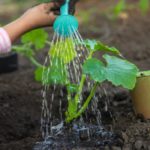Giving your grass the right amount of water is essential, but that involves more than just installing a sprinkler system and letting it do the trick. With too much water, your lawn will become susceptible to disease and rot, while not enough water will make the lawn patchy and dry. So, how do you get it right?
How long and how often you should water grass depends on the kind of grass (cool- or warm-season), type of soil (clay or sandy), and your location. Generally, grass needs 1-1.5 inches of water weekly. Keep an eye out for signs of under- or over-watering, and never water your grass at night.
To make sure your lawn flourishes, let’s take a look at how often, how much, and when you should water your grass. We’ll also take a look at how the watering needs of cold- and warm-season grasses differ, and how you can tell if you’ve over- or under-watered your grass.
How Often Should You Water Grass?

Ideally, you should water your grass 1-2 times a week, giving it around 1-1.5 inches of water in total. The exact time period for which you should water the grass varies from one lawn to another and depends on a few factors such as how big your lawn is, the kind of sprinkler you’ve installed, and the mode or settings of your sprinkler.
To understand how often you should really water the grass, you first need to determine how much water your lawn needs every week. As mentioned above, an average lawn needs 1-1.5 inches of water every week but this varies based on the type of turf grass (whether warm-season or cool-season), the time of the year (dormant or active warmth season), and the exact type of grass.
The watering needs also depend on how much your lawn has grown. Regardless of whether you have a newly seeded, plugged, sodded, or sprigged lawn, you just can’t depend on rain to give sufficient water to your lawn, especially if it’s the first year of its growth. You should always provide additional irrigation.
In the case of a newly seeded lawn, you should focus on keeping the top one inch of the ground moist. To do so, you’ll need to use a mister on the seeded area 1-2 times a day, or even more if it’s very dry and hot outside.
Once the seeds germinate, you should keep the top couple of inches of the soil moist and continue doing so until the grass grows up to a mowing height (roughly 3 inches). Once the grass fully grows, you can switch to infrequent deep watering sessions two times a week. You should give enough water to the lawn to keep 6-8 inches of soil moist so that grassroots grow deeper into the ground.
Other Factors to Keep in Mind
How often you should water the grass also depends on where you live because of the differences in the weather conditions in the summer and the amount of rainfall in your area. Grass requires water the most during a heatwave or when the winds are high and humidity is low.
Also, remember that natural rainfall cuts down on the amount of supplemental irrigation you need to provide. You can easily figure out how much water you need to give to your plant when it rains by simply subtracting the amount of rainfall (in inches) from your lawn’s weekly watering needs.
So, if you need to give your lawn one inch of water per week, and you get ½ inch of rain during that time period, you only need to give your lawn ½ inch more. This means that if your sprinkler’s output is 1.5 inches weekly, you should only run it for 20 minutes or 10 minutes if you water the lawn 2 times a week (just for that week).
The kind of soil is also important to consider when figuring out how often you need to water the grass. Clay soil can retain water for much longer and doesn’t need to be watered as frequently as sandy soil, which tends to drain much quicker and needs more frequent watering.
Determining Your Grass Type
Different kinds of grass need different kinds of care to stay healthy and hardy. Grass can be divided into two types: cool-season and warm-season grasses.
Cool-season grasses grow in the fall and include bluegrass, rye, and fescue. You need to give them roughly 1-1.5 inches per week until the end of the growing season, which is typically when the first frost starts to set in. If you don’t give water to cool-season grasses in a drought, they’ll go dormant, but they’ll turn green again once it starts raining.
Warm-season grasses grow mostly in the summer, can withstand drought better than cool-season grasses because of their deep root systems, and include species like zoysia, Bermuda, centipede, and St. Augustine grass. While they need relatively less amount of water compared to cool-season grasses, they still need additional water during a heatwave.
In general, the watering needs for both kinds of water are high in the active season, which is mid to late spring to early fall for warm-season grasses and fall and spring for cool-season grasses. They don’t need too much water when they’re dormant, which is in winter for both types of grass.
For instance, Kentucky bluegrass (a cool-season grass) requires 1.5-2 inches of water every week during the active season and only half an inch during the dormant season. Meanwhile, Bermuda (a warm-season grass) only needs 1-1.25 inches per week during the active season and only ⅛ inches weekly during the dormant season.
How to Tell if You’ve Over- or Under-Watered Your Grass

It’s quite easy to tell if you’ve given too much or too little water to the grass. If you give too much water, the ground will become very soggy and attract fungus, pests, and excess thatch. Plus, you’ll see the wasted water run off and ruin the hardscape.
Meanwhile, if your green lawn starts to turn gray or if the grass blades start to curl, it’s a clear sign that it needs more water. If you’re not sure, there are two tests you can try out: the step test and the screwdriver test.
In the step test, all you really need to do is walk on the lawn. If the grass springs back up immediately, that means the grass is well-watered. But if it doesn’t, that means it lacks moisture and that you need to water it.
For the screwdriver test, take a long-bladed screwdriver and drive it 6 inches deep in the soil. If you’re unable to push it that far or if you get a lot of resistance, you need to water the grass.
How to Measure Your Water Output
There are a number of ways to measure water output.
The first thing you can do is determine the sprinkler system’s output (the amount of water it delivers in an hour). To do so, take 6 straight-sided containers and place them somewhere on your lawn where the sprinklers hit. Make sure that all the containers are of the same shape and size.
Now, let the sprinklers run for 20 minutes and measure how much water is present in each container using a ruler. Calculate the average depth of the water across all the containers and multiply it by 3 to get your sprinkler’s output.
Another way to determine the water output is to use tuna cans. Put two empty, clean tuna cans in two different parts of the lawn where the sprinklers hit. Let the sprinklers work for 15 minutes and, just like you did with the first method, measure the depth of water present in each can using a ruler. Finally, take the average of the two to know the water output.
You can also use a water or flow timer like this one from Rainpoint (on Amazon) and add it to your sprinkler line to measure the output. Such timers measure the flow of the water in gallons and track the actual use. With the timer installed, all you need to do is multiply your lawn’s square footage by 0.62 gallons, and you’ll get the amount of water you need for the whole lawn.
Should You Water the Grass at Night?
If it’s impossible for you to water the grass early in the morning, then you should water it in the evening (4-6 pm) but never at night, especially if it’s late. While the nights are cooler, the water will stay on the grass overnight and make the grass more susceptible to diseases.








